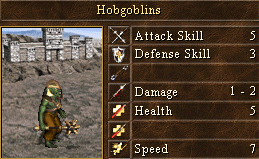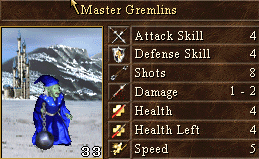You should already know what happens if 75 Black Dragons attack 4 skeletons. The Black Dragons do a ton of damage, the Skeletons all die, and you win the battle amidst a pile of charred bones. Unfortunately, most battles are not so simple and understanding what actually happens when you make an attack will allow you to use more strategy in combat. You should understand all of the information in Combat Training 1 before reading this section.
Sample Creatures
Here are the creatures I'll be using in this article with all of the important information.
- Attack Skill represents how effective the creature is at making attacks
- Defense Skill represents the creature's ability to fend off attacks
- Shots is how many times the creature can shoot if it's capable of making ranged attacks
- Damage represents the range of damage the creature can do in combat
- Health is how much damage the creature can take before it dies
- Health Left shows how much health the top creature on the stack has left
- Speed is how many hexes the creature can move in a round of combat
Now I'm going to talk a bit about the actions the creatures can take in combat.
Move, Wait, and Defend
Suppose a stack of 20 Skeleton Warriors enters combat with a stack of 20 Hobgoblins. The Hobgoblins have the highest speed, so they get a turn first. The Hobgoblins could move up to 7 hexes on the map because their speed is 7, but they choose to Wait instead. Why would they want to wait? Well, the battlefield is 15 hexes across, so they know the Skeleton Warriors (who only move 5) can't reach them. It is to their advantage to wait and see what the Skeleton Warriors are up to, so they can react to their action. The Skeleton Warriors choose to wait as well, because they can.
Now that all of the creatures have taken an action, the First Movement phase is over. There are no war machines in the battle, so the War Machines phase is skipped and the Second Movement phase begins. Remeber that in the Second Movement phase, creatures move in order from slowest to fastest, instead of fastest to slowest, and only creatures that waited in the First Movement phase get a turn.
Since the Skeleton Warriors have the lowest movement speed, it is their turn again. (Notice that the Skeleton Warriors gained nothing by waiting in this situation because they are slowest.) The Skeleton Warriors don't have much to do, so they choose to Defend. Choosing Defend raises the Defense Skill of the Skeleton Warriors by 20% until their next turn. In this case, it would raise their Defense Skill from 6 to 7 (fractions are rounded down). Now it is the Hobgoblins turn. They move 7 hexes towards the Skeleton Warriors. This ends the first round of combat, because all creatures are done moving. When the next round of combat begins, it will again start with the fastest creature which is the Hobgoblins.
Special Ability
Some Creatures have special abilities that can be used in combat. None of the creatures shown here have a special ability, but you can look at the creature descriptions to see which ones do. An example is that Ogre Magi can cast Bloodlust on friendly creatures.
Ranged and Melee Attacks
Ok, back to the battle! It was the beginning of the second round, and the Hobgoblins are up. The Skeleton Warriors are within range of the Hobgoblins movement, so the Hobgoblins choose to make a Melee attack. Whenever a stack of creatures makes a melee attack, they will (hopefully) kill some creatures, and then any surviving creatures in the attacked stack will make a retaliation (counterattack) to (hopefully) kill some of the attackers. Each stack of creatures may make 1 retaliation per round of combat.
If the Master Gremlins were in this fight, they could make a ranged attack. Ranged attacks cannot be retaliated against, not even by other ranged creatures, but they only do half damage if the target is more than 10 hexes away. Ranged creatures can not shoot if an enemy stack is standing next to them. In that case, they must move or make a melee attack, but most ranged creatures only do half damage in melee combat.
Damage Calculation
Damage calculation works like this.
- A random number is chosen within the creature's range of damage. For example, the number 1 or 2 would be randomly selected if Hobgoblins were making an attack.
- The damage is multiplied by the number of creatures in the attacking stack. For example, 20 attacking Hobgoblins dealing 2 damage each would do a total of 40 damage.
- The damage is adjusted by comparing the attacker's Attack Skill and the defender's Defense Skill. The attacker's damage is increased by 5% for every point their Attack Skill is above the defender's Defense Skill or the attacker's damage is reduced by 2.5% (round half percents down) for every point the defender's Defense Skill is above the attacker's Attack Skill. For example, the Skeleton Warriors defense skill of 6 is 1 point higher than the Hobgoblins attack skill of 5, so the Hobgoblins damage would be reduced by 2%. (2.5% rounded down) That means the Hobgoblins 40 damage would be reduced to 39. (40 damage * 98% = 39.2 damage).
- Damage is applied to the top creature in the stack. If the top creature is killed, any remaining damage is applied to the next creature in the stack. This repeats until all damage is applied. For example, if the 20 Skeleton Warriors took 39 damage, the top 6 Skeleton warriors would die, and the remaining 3 damage would be applied to the top creature on the stack of 14 remaining Skeleton Warriors. (the first 36 points of damage kills the first 6 Skeleton Warriors because they each have 6 life)
Let's calculate this based on the combat that's in progress. When we last left off, the Hobgoblins were about to Attack the Skeleton Warriors who were currently Defending.
20 Hobgoblins attack:
- Suppose the number 2 was randomly chosen for the damage.
- 2 damage * 20 Hobgoblins attacking = 40 damage.
- 40 damage * 95% = 38 damage (remember the Skeletons increased their Defense to 7 by defending).
- 6 Skeleton Warriors die, and the top creature on the stack has 4 health remaining (it took 2 damage).
Since the Skeleton Warriors were attacked, they automatically retaliate (counterattack):
- Suppose the number 2 was randomly chosen for the damage (the choices were 1, 2, and 3)
- 2 damage * 14 Skeleton Warriors attacking = 28 damage
- 28 damage * 115% = 32 damage (Skeletons Attack is 3 points higher than Hobgoblins Defense)
- 6 Hobgoblins die, and the top Hobgoblin in the stack has 3 health remaining (it took 2 damage)
The Hobgoblins have taken their turn, and the Skeleton Warriors automatically retaliated to the attack. Since a stack of creatures only gets one retaliation per round of combat, the Skeleton Warriors would not be able to retaliate again if another stack of creatures attacked them before the round ended. Of course, there aren't any other creatures in this battle, so the Skeleton Warriors don't need to worry. Now it's the Skeleton Warrior's turn!
The Skeleton Warriors choose to attack the Hobgoblins:
- The number 3 is randomly chosen from the Skeleton Warriors damage range of 1-3
- 3 damage * 14 Skeleton Warriors = 42 damage
- 42 damage * 115% = 48 damage
- The first 3 damage kills the injured Hobgoblin, and the remaining 45 damage kills 9 more, so a total of 10 Hobgoblins die.
The 4 surviving Hobgoblins retaliate:
- The number 1 is randomly chosen for damage
- 1 damage * 4 hobgoblins = 4 damage
- 4 damage * 98% = 3 damage (skeleton warriors are no longer defending)
- This does not even kill one Skeleton Warrior, but reduces the top one on the stack to 1 health.
The second round of combat is over now because both creatures took their actions, and neither of them waited. Now there are 14 Skeleton Warriors (one is injured) and 4 Hobgoblins remaining. From this point, it is pretty clear that the Skeleton Warriors will win the fight if it continues. Due to the random factor, it is possible that the Hobgoblins could win a similar fight to the one outlined here.
Last Words
I should also point out that the "random number" that is chosen for the damage each round is random, I was just picking the numbers myself for this example to illustrate how it works. Normally, you don't know what the damage will be. In the Fantasy Deathmatch section of this site, I will be using the average damage, instead of picking one of the numbers randomly. So, if the Skeleton Warriors were fighting in the Fantasy Deathmatch section, I'd list their damage as 2 every time they attack (average of min and max damage) and I'd list the Hobgoblins damage as 1.5.
In actual combat, creatures with a wide range of damage can yield unpredictable results. You could get lucky and deal max damage twice in a row, or you could be unlucky and deal minimum damage over and over again. You have to keep both possiblities in mind when playing. You don't need to whip out a calculator and do the math during a game, but understanding how the system works and making quick estimates can really help.



